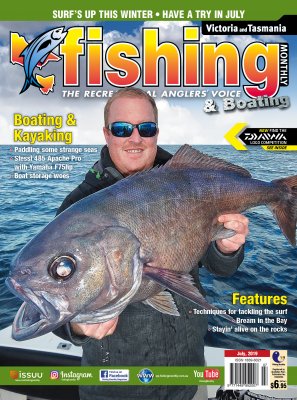Techniques for winter surf fishing by Jarrod Day
 Surf fishing is nothing new to Victorian anglers. In fact, on any given weekend day it is common to see the beaches lined with anglers all trying their luck. Sometimes - depending on the beach being fished - it can be challenging getting your own piece of sand to make a cast.
Surf fishing is nothing new to Victorian anglers. In fact, on any given weekend day it is common to see the beaches lined with anglers all trying their luck. Sometimes - depending on the beach being fished - it can be challenging getting your own piece of sand to make a cast.
Winter is the peak time to target Australian salmon, but they can be challenging to find at times. With such a broad coastline, salmon can be in numbers at one beach one day and a different beach the next.
When choosing which beach to head to you should consider two main things. 1. Keep an eye on your local fishing reports and social media and 2. Keep an eye on the weather and head to a beach where the wind is blowing directly into it.
Often, the rougher the weather, the more chance the fish will school up in the wash searching out easy meals that are washed around with the surges.
DIRTY OL' BAIT
Surf fishing techniques can vary quite a bit from angler to angler but the basics should be the same.
Rod selection should be based on how you fish, not where you fish. For instance, while it is common practice to attempt to cast as far as you can to reach deeper water, this mindset will not get you far. Gutters or rips as they are commonly known to surfers and swimmers, are where you'll find the bulk of the fish holding due to the water's depth.
In many cases, these gutters run right into the shore break meaning that the fish can be right at your feet. If you're trying to cast to oblivion, then you could be casting over the top of the school of fish. This is also true should you be using berley because the fish will swim right into the shore break following the food source.
While it is common fact to use long surf rods, your choice should be based on how you're going to fish. In most surf fishing cases, a 9-10ft rod is recommended because they can be used for multiple techniques, including bait fishing and casting lures.
While I use berley to attract the fish to my gutter, there is no need to make long casts, in fact, I'd be lucky to cast more than 10m into the surf. This is because if there are any fish in the gutter I'm fishing, they will move right into the shore break.
A technique I swear by is to establish a berley trail on your arrival before setting up your rods and rigs. This is because while you're setting up, the berley trail is being created and subsequently attracting the fish. Usually by the time you have set-up, the fish will already be in your gutter.
Rigging for salmon is quite simple, but there are also mullet and silver trevally, which are common catches and can be caught in the same gutters.
The humble paternoster rig is undoubtedly the most effective rig for surf fishing and can be set-up in numerous ways. While most Victorian salmon don't exceed 3kg in weight, with the average being 1.5kg in season, there is no need to tie rigs from a leader strength greater than 15lb. An exception to this is when there is a strong wind blow, which will rip up kelp and other seaweed from the seafloor. This is then pushed up to the surface and washed into the beaches. During these days, you may need to use a heavier leader so as not to get busted off on the floating debris.
Hook choice is also critical and more often than not, anglers go in for the kill and use hooks too large in size for the fish that are about. Small hooks will catch big fish too.
Paternoster rigs in the surf should contain two droppers to increase your chance at hooking fish, but be mindful of the bottom dropper being too close to the sinker. The reason being is that sand crabs also like an easy meal and often chew up the bottom bait if they can get to it.
In also avoiding the crabs from stealing baits, a surf popper or soft plastic can be used on the bottom dropper, which is also effective.
My rig tends to comprise of the top dropper containing a Mustad 1/0 redbait holder hook containing bluebait while the bottom dropper has a Mustad #8 bloodworm long shank hook tied to it, which is laced with a pipi bait.
Once all this is set-up, vary your casts starting in shallow and slowly work your way out in the gutter. At some point, you'll get a bite and if you can remember where you made the cast, replicate it on the next, as this is where the fish are likely to be holding.